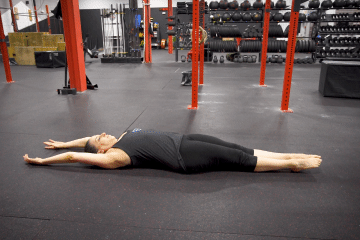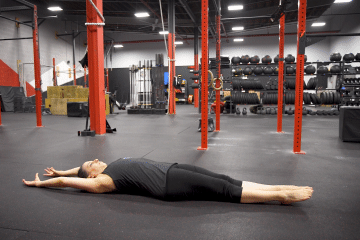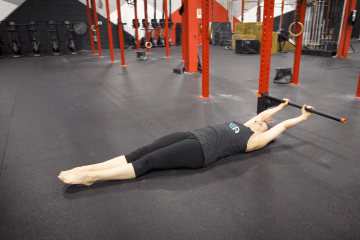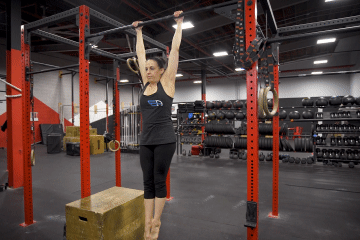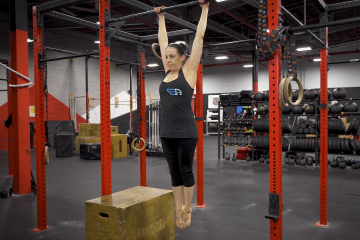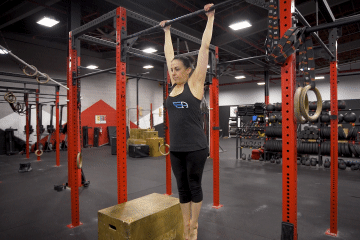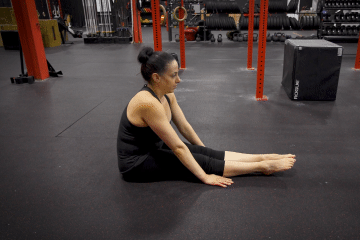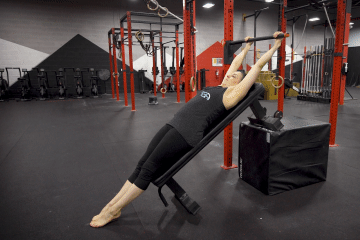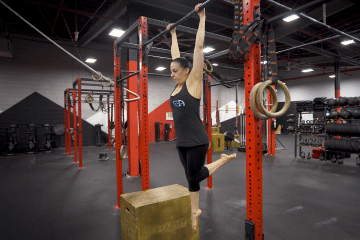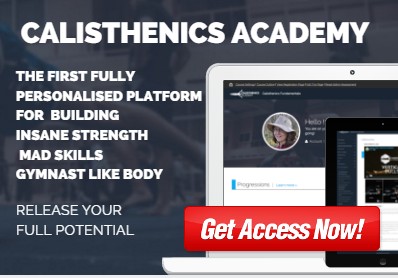Do you want to improve your core strength and flexibility but are unsure how to perform the challenging v-leg raise exercise?
Leg raises are a fantastic exercise that targets the lower abdominal muscles and improves your overall body control.
In this article, you will learn how to master the v-leg raises. We will cover the prerequisite progressions of the skill, the muscles used, and its benefits. Let’s dig in!
🔥What are Hanging V-Leg Raises?
Hanging straight V-leg raises, often called hanging leg raises or simply leg raises, are challenging and effective abdominal exercises targeting the lower abs, hip flexors, and core muscles.
This exercise involves lifting both legs from a hanging position to create a “V” shape with your body, hence the name “V Raises.”
Hanging v-leg raises are an excellent addition to any core strengthening regimen. They provide a targeted workout for the lower abs and hip flexors while improving core stability and grip strength.
Remember to start at your fitness level, gradually progress, and prioritize proper form for maximum benefit and safety.
✨11 Progressions to Success
Progressions to v-leg raises are specifically crafted to gradually build your strength and flexibility, making the v-leg raise exercise more accessible and effective for all fitness levels.
Here are progressions for beginners and advanced athletes to master this impressive core exercise.
1. 🙌 V-Ups
V-ups are essential for your safety and serve as a pre-requisite to ensure you have the necessary physical readiness to tackle the v- leg raises effectively.
They are a dynamic core exercise that actively engages your abdominal muscles, emphasizing the lower and upper regions. This exercise mimics the leg-raising motion encountered in the v-leg raise.
This exercise strengthens your entire abdominal region, including the lower abs, hip flexors, and core. By mastering V-Ups, you’ll develop the muscle control and strength required for the leg raise to V.
How to perform
Begin by lying on your back with your arms extended overhead and your legs straight. Simultaneously lift your upper body and legs, bringing them together in a V shape. Reach your hands toward your toes before lowering your upper body and legs back down with controlled precision.
2. 🙌 V-Up Hold
The V-Up Hold is an isometric variation of the V-Up exercise, focusing on holding the peak position to improve core stability and balance.
By performing the V-Up Hold, you enhance your core’s endurance and learn to sustain stability in the challenging “V” position, a fundamental skill needed for the v-leg raise.
How to perform
Commence in the V-up position, with your upper body and legs lifted off the ground, forming a V shape. Maintain this position for as long as possible, concentrating on stabilizing your core and balancing your body.
3. 🙌 Supine Leg Raise to V on Floor
Supine leg raises primarily target the lower abdominal muscles and teach you how to control the movement of your legs.
This exercise strengthens the lower abdominal muscles, aiding in the development of leg-lifting control and core engagement. This exercise is essential for mastering the leg raise to V.
How to perform
Lie flat on your back with your legs fully extended. Place your hands under your hips for support. Lift your legs straight towards the ceiling, keeping them together, then lower them back down without allowing your feet to touch the ground.
4. 🙌 Hanging Knee Raise
The “Hanging Knee Raise” is your first progression on the bar itself. These are foundational exercises that lay the groundwork for more advanced core workouts.
By targeting the lower abdominal muscles, this exercise builds the strength and stability needed for more challenging movements.
How to Perform
Begin from the standard straight-arm, straight-body hanging position. This progression introduces different levels of lift.
To start, raise your knees to the tuck position, aligning them with your hips. As you progress and your strength improves, work on bringing your knees even closer to your chest, with the goal of getting your thighs as close to your chest as you can.
5. 🙌 Hanging Straight Leg Raise
The hanging straight leg raise is an intermediate core exercise that builds on the hanging knee raise. It focuses on strengthening the lower abdominal muscles and requires you to lift your legs to a horizontal L-shape.
How to Perform
Hang from a pull-up bar with straight arms and a straight body. Lift your legs until they are parallel to the ground, forming an L-shape with your body. Lower your legs back to the starting position with control.
6. 🙌 Hanging L-Sit
The Hanging L-Sit is an endurance-focused exercise that challenges your core strength. It involves maintaining a seated position while hanging from a pull-up bar.
How to Perform
Hang from a pull-up bar with straight arms and extend your legs in front of you, keeping them together. Hold this position for at least 10 seconds or longer to improve your muscular endurance.
7. 🙌 Hip Flexor Lifts
Hip flexor lifts are ground-based exercises designed to enhance hip mobility and flexibility. They target the lower abdominal muscles and hip flexors.
How to perform
Lie on your back with your legs straight and your arms extended above your head. Lift both legs off the floor while keeping them straight. The objective here is to lift both legs off the ground without allowing your heels to touch. Gradually move your hands closer to your hips to increase the difficulty and range of motion.
8. 🙌 Angled Leg Raises
Angled leg raises provide a variation between horizontal and vertical leg raises. You can find yourself in an intermediate position at roughly a 45-degree angle. The setup can be adjusted as needed, typically involving a bench on an elevated surface and the use of a bar.
Gravity plays a role in assisting you during this stage, though it still demands the same focus on cues, range of motion, and technique as the previous leg raise progressions.
How to perform
Position yourself at an angle between horizontal and vertical leg raises. Focus on maintaining proper form and technique throughout the movement.
9. 🙌 Leg Lift with One Leg Tuck
A leg lift with one leg tuck is an exercise that helps develop control and balance in the core. It involves alternating between lifting one leg with a tuck and lifting the other leg straight.
How to perform
Begin in a straight body position and bend one leg at the knee while keeping the other straight. Perform a leg lift with the straight leg, then switch to the bent leg. Alternate between legs to work on both individually.
10. 🙌 Hanging Straight Leg V-Raise
The hanging straight V-leg raise is an advanced core exercise that combines strength and control. It requires you to touch the bar with your feet while hanging from a pull-up bar.
How to perform
Start with a straight-arm hang on the bar. Lift your legs until they touch the bar, and then perform a slow and controlled descent, maintaining proper form and control throughout the movement.
11. 🙌 Leg Raise One and a Half
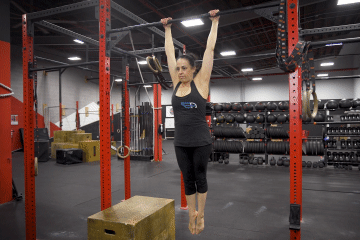
Leg raise
Leg raise one and a half is a challenging core exercise that combines elements of leg raises, L-sits, and V-ups. It tests your core strength and control.
How to perform
Begin in a straight body position. Perform a full leg raise, then lower your legs halfway down and raise them again before returning to the starting position. This combination of movements challenges your core muscles effectively.
Remember to consult with a fitness professional or physician if you have any underlying health concerns or injuries before attempting this or any new exercise. Always prioritize safety and proper form to avoid strain or injury.
Check out our other leg workout articles:
📍Leg Raises Progression
📍Calisthenics Leg Workout
📍17 Explosive Calisthenics Leg Exercises
💪Muscles Used
Understanding the specific muscles involved in the v-leg raise is essential for effectively targeting and strengthening these muscle groups. Proper form and control are crucial throughout the exercise to maximize benefits and minimize injury.
Here are several muscles used for the hanging straight leg V raises:
👊Psoas
The psoas major is a deep-seated muscle that runs from the lumbar spine through the pelvis and attaches to the top of the femur. It plays a critical role in hip flexion.
This muscle is heavily engaged during the upward phase of the leg raise to V as it flexes the hips to raise the legs. It is essential for achieving the V shape.
👊Rectus Abdominis
The rectus abdominis is the well-known “six-pack” muscle, running vertically along the front of the abdomen. It’s responsible for flexing the trunk.
The rectus abdominis plays a central role in lifting the legs and maintaining the body in V throughout the exercise. It is the primary muscle responsible for the flexion of the lumbar spine.
👊Rectus Femoris
The rectus femoris is one of the quadriceps muscles located in the front of the thigh. It crosses both the hip and knee joints.
This muscle assists in hip flexion during the initial phase of lifting the legs in the Leg Raise to V. It works with the psoas and plays a vital role in achieving the desired leg position.
👊Adductors
The adductor muscles are located on the inner thigh and are responsible for bringing the legs toward the body’s midline.
While not the primary movers, the adductors play a stabilizing role during the leg raise to V by helping to keep the legs together throughout the movement.
👊Forearms
The forearm muscles consist of various muscles responsible for wrist and hand movements.
The forearms maintain a strong grip on the bar throughout the exercise, ensuring stability and control during the hanging phase.
👊Lats (Latissimus Dorsi)
The latissimus dorsi, or lats, are the large back muscles extending from the upper arm to the lower back. They are involved in various shoulder and arm movements.
The lats are engaged during the descent phase of the leg raise to V. They help control the lowering of the legs and provide stability as you return to the hanging position.
🏆Benefits
Mastering the perfect v-leg raise offers many benefits, including core strength, improved flexibility, enhanced hip flexor function, and exploring advanced calisthenics skills. These benefits extend beyond aesthetics and contribute to fitness, health, and functional movement capabilities.
✅ Stronger Core
Mastering the v-leg raise is an exceptional way to strengthen your core muscles, including the rectus abdominis, obliques, and transverse abdominis.
A stronger core offers better support for the spine and pelvis, reducing the risk of lower back pain and injury. It enhances your ability to maintain proper posture during everyday activities and workouts.
✅ Improved Flexibility in Hamstrings and Back
The v-leg raise requires a degree of flexibility, particularly in the hamstrings and lower back, to achieve the full range of motion.
The hamstrings are the muscles at the back of the thigh, responsible for knee flexion and hip extension. The lower back includes the lumbar spine, which requires flexibility to maintain proper form during leg raises.
Improved hamstring flexibility reduces the risk of muscle strains and enhances overall lower-body mobility. Greater lower back flexibility can alleviate tension and discomfort, especially for individuals with sedentary lifestyles.
✅ Enhanced Hip Flexor Strength
The Leg Raise to V heavily engages the hip flexors, a group of muscles that allow you to lift your legs toward your torso.
The hip flexors include the psoas major, iliacus, and rectus femoris muscles. Enhanced hip flexor strength improves hip mobility and stability, essential for various activities such as walking, running, and cycling.
Strong hip flexors can alleviate hip pain and discomfort, especially in individuals with sedentary jobs or sitting for prolonged periods.
💪Progression Towards Advanced Calisthenics Skills
The V-leg raise is not just an exercise; it’s a foundational skill in 📍calisthenics that opens the door to more advanced movements. Mastering theV- leg raise can be a stepping stone to advanced exercises like pull-overs, press to handstand, and the single-arm leg raise to V.
Progressing to advanced calisthenics skills offers new challenges and keeps workouts engaging and motivating. It enhances overall body control, strength, and athleticism, allowing you to achieve impressive feats of strength and flexibility.
Do you want to work on your handstand? Check out our articles on handstand:
- 📍 Mastering the Art of Handstand: Progression, Muscles Used, and Benefits
- 📍 Mastering Freestanding Handstand: 11 Progressions to Success
- 📍 From Beginner to Pro: 7 Progressions for the Perfect Wall Handstand
👀How Long Does It Take?
The time it takes to master the V-leg raise varies from person to person. It depends on your current level of strength and mobility. Some may achieve it in a few months, while others may take a few years. The key is consistent practice and patience.
🧐Frequently Asked Questions:
🔎 What muscles do hanging straight leg V raises work?
Straight leg V raises primarily target the lower abs, hip flexors, and core muscles. They also engage the forearms and lats for stability.
🔎 Are hanging straight leg V raises suitable for beginners?
Hanging straight leg V raises is an advanced exercise. Beginners should start with easier core exercises and gradually progress to hanging leg raises.
🔎 How do I prevent swinging during Hanging Straight Leg V Raises?
To minimize swinging, focus on controlled movements. Engage your core, keep your legs straight, and avoid using momentum. Start with bent knee raises if necessary.
🔎 How can I increase the difficulty of hanging straight leg V raises?
To make the exercise more challenging, add ankle weights, increase the range of motion, or perform variations like L-sit raises or Single-Leg hanging raises.
🔎 Are there any common mistakes to avoid when doing hanging straight leg V raises?
Common mistakes include using excessive momentum, not maintaining a straight body, and neglecting proper breathing. To avoid these, prioritize controlled movements and proper form throughout the exercise.
💥Conclusion
Mastering the perfect V-leg raise is a challenging yet rewarding endeavor with many benefits. This comprehensive progression guide has equipped you with the knowledge and techniques necessary to develop core strength, improve flexibility, enhance hip flexor function, and unlock the potential for advanced calisthenics skills.
Remember that achieving mastery in this skill is a journey that demands dedication and precision.
The time it takes to master the V- leg raise is highly individual, depending on your starting point and consistent effort. Whether it takes a few months or several years, stay committed to your training regimen, prioritize proper form, and enjoy the journey of self-improvement in the world of calisthenics.
Looking for the most effective at-home bodyweight strength training program? The Movement Athlete offers a lifelong, progressive, and effective bodyweight training program.
Take a Free Assessment now to receive a detailed, personalized training plan that includes workouts and recommendations you can use right away.

